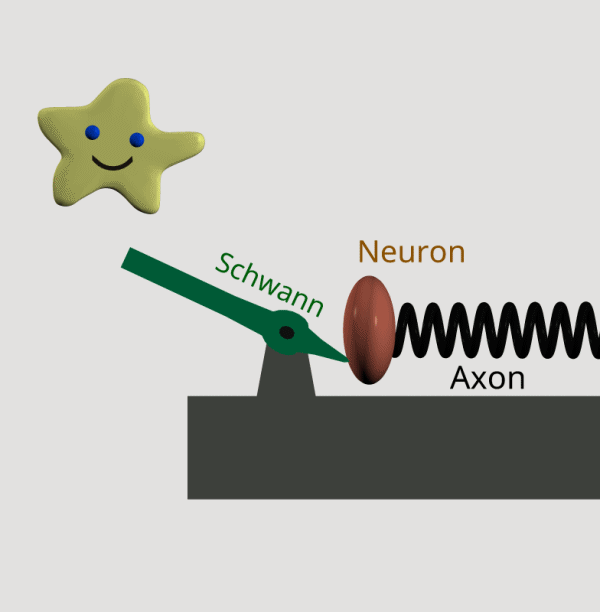Monday, September 16, 2019
Starting to get somewhere
Some AI researchers are finally peeking outside their digital bubble and returning to analog technology.
Cybernetics started in analog form with tubes, and was developing quickly in the '60s. In the '70s, of course, analog was abandoned and all grants went to exponentially larger and exponentially more purposeless digital computers.
These researchers finally caught onto the fact that the brain is analog. Their device isn't revolutionary; it's an extremely small and efficient Gauss-curve function. The same thing could be done with mechanisms, as I illustrated last month...
 ... or it could be done with tubes or plain FETs or a pair of biased germanium diodes.
It's not clear from the summary why they want Gauss; neurons do Tanh, not Gauss.
A bit later after looking again at the Schwann stuff: Yeah, Gauss makes sense. Gauss is the derivative** of Tanh. Most neurons have a Tanh curve, but the purpose of a sensory system is a soft two-way change detector. If you're modeling the black-box behavior instead of the transfer function of a single neuron, you want Gauss. The recently discovered Schwann sensors implement Gauss directly, as does this device.
** Well, strictly speaking Gauss is the rectified or absoluted derivative of Tanh.
... or it could be done with tubes or plain FETs or a pair of biased germanium diodes.
It's not clear from the summary why they want Gauss; neurons do Tanh, not Gauss.
A bit later after looking again at the Schwann stuff: Yeah, Gauss makes sense. Gauss is the derivative** of Tanh. Most neurons have a Tanh curve, but the purpose of a sensory system is a soft two-way change detector. If you're modeling the black-box behavior instead of the transfer function of a single neuron, you want Gauss. The recently discovered Schwann sensors implement Gauss directly, as does this device.
** Well, strictly speaking Gauss is the rectified or absoluted derivative of Tanh.
 ... or it could be done with tubes or plain FETs or a pair of biased germanium diodes.
It's not clear from the summary why they want Gauss; neurons do Tanh, not Gauss.
A bit later after looking again at the Schwann stuff: Yeah, Gauss makes sense. Gauss is the derivative** of Tanh. Most neurons have a Tanh curve, but the purpose of a sensory system is a soft two-way change detector. If you're modeling the black-box behavior instead of the transfer function of a single neuron, you want Gauss. The recently discovered Schwann sensors implement Gauss directly, as does this device.
** Well, strictly speaking Gauss is the rectified or absoluted derivative of Tanh.
... or it could be done with tubes or plain FETs or a pair of biased germanium diodes.
It's not clear from the summary why they want Gauss; neurons do Tanh, not Gauss.
A bit later after looking again at the Schwann stuff: Yeah, Gauss makes sense. Gauss is the derivative** of Tanh. Most neurons have a Tanh curve, but the purpose of a sensory system is a soft two-way change detector. If you're modeling the black-box behavior instead of the transfer function of a single neuron, you want Gauss. The recently discovered Schwann sensors implement Gauss directly, as does this device.
** Well, strictly speaking Gauss is the rectified or absoluted derivative of Tanh.
